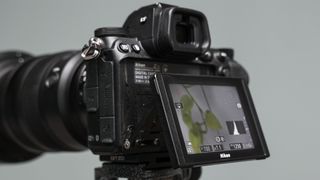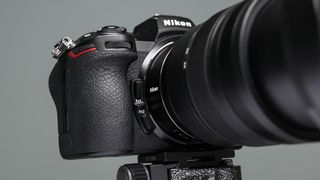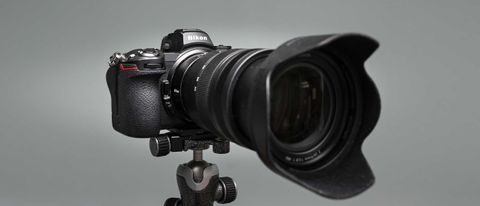Space Verdict
Outstanding in its field, the Nikon Z7 II combines power, speed and precision with a simple interface and organized button layout in an attempt to master all trades, rather than become the jack.
Pros
- +
Excellent high ISO handling
- +
Brilliant EVF view aids composing at night
Cons
- -
Out of the price range of most beginners
- -
No longer the best low light autofocusing range
Why you can trust Space.com
The Nikon Z7 II is a full-frame mirrorless camera designed to perform well across a range of photographic genres and is the successor to the Nikon Z7. Its stills resolution is a whopping 45.7MP, matching that of the DSLR equivalent the Nikon D850. It also shoots 4K60p video to produce smooth-looking, highly detailed movies.
Fitted with a Z-mount lens connection it works with all Z lenses but is also compatible with F-mount lenses when using the FTZ adapter. The Nikon Z7 II has an incredibly wide ISO range from 64-25,600 which jumps to 32-102,400 when expanded. The 0.5-inch 3.69k-dot electronic viewfinder can be color balanced and has 11 different brightness levels that can be controlled manually for a variety of shooting situations.
Considering its rather comprehensive features it’s still rather slim and lightweight. The camera body itself weighs just 615g and has dimensions of 5.3 x 4 x 2.8-inches which means it easily slips into even the smallest of camera bags or pouches.
The camera features dual memory card slots, one allowing up to UHS-II SD cards and the other XQD or CFexpress cards. This is particularly sought after for professionals where missing out on the shot of a lifetime because a card is corrupted isn’t an option. The Nikon Z7 II gives users the option to use the cards in conjunction for image overflow (switching from one card to the other) or for backup (by copying the images and videos to both cards simultaneously). Handily, the two card slots can be used to sort RAW images from JPEGs or stills from video to help speed up workflow for hybrid shooters and image editors.
Nikon Z7 II review: Design
- Tilting screen is useful for keeping hands on buttons
- Weather sealing protects it from the elements
- Button layout unmistakably Nikon

Overall, the design of the Nikon Z7 II is very similar to the original Z7 and feels very much like a miniature Nikon DSLR with similar button placements, switch controls, and command dials that feel like they draw upon the SLR and DSLR heritage design.
Because of this, anyone who’s shot with a Nikon before should instantly feel at home when picking up this camera. Its design should appeal to many types of shooters from wildlife photographers to photojournalists, and online hobbyist short filmmakers to professional video recordists.
A key part of what makes the design of the Nikon Z7 II so great for astrophotography is the tilting rear touchscreen. At first we thought that omitting a vari-angle screen would be detrimental to the astro shooting experience, but actually, a tilting screen is far more ideal. Since it doesn’t fold out and twist round, so the hands stay close onto the camera body, with buttons within fingertip distance.

This attention to detail is paramount when shooting in the dark and negates the need for bright torches to navigate camera settings on the body when trying to preserve night vision which is so valuable for low light and astrophotography.
Great to use at night or in the day, its also fully weather sealed. That means photographers or videographers need not worry about taking the camera out in rain, snow, or dusty conditions because internal components are safe from material ingress.
Nikon Z7 II review: Functionality
- Fn buttons on front of body aid customization
- Distance gauge flashes up on rear screen when manually focusing
- A compatible lens’ display screen helps gain focus

The Nikon Z7 II is as pragmatic as it is functional, with a swathe of key settings and controls improved upon from the previous model. Without feeling overcrowded there are controls all across the camera body with two notable Fn buttons on the front of the camera useful for customizable shortcuts.
They sit exactly where the fingers fall when gripping the camera body with the right hand and are ideal for programming features specific to any kind of photography. We experimented with this by allowing one button to open the screen brightness controls as this makes it easier to deal with the camera when trying to save night vision.

When manually focusing (as one will do a lot in astro work), a turn of the focusing ring brings up a gauge on the rear screen showing the focusing distance selected. Though there’s a small lag between the turn and the gauge changing this is still extremely useful to keep track of focus to ensure subjects are pin-sharp even when it’s hard to see them on-screen. We expect the small lag is either idiosyncratic of the model we reviewed or due to the slower shutter speed required when shooting at night.
Some Z-mount lenses have a display screen built right into the lens barrel itself. So when the Z7 II is paired with an appropriate lens we can ascertain focus and camera settings from this display without ruining the night vision by having to stare at the rear screen or the EVF.
Nikon Z7 II review: Performance
- High ISO image noise is fantastic
- Exposure preview is one of the best
- Automatic white balance is superb

One thing that stands out about the Nikon Z7 II compared with the competition is its superb handling of high ISO image noise. In our experience we’ve found that image noise is almost unnoticeable until we reached around ISO2500. Even when it creeps in as the ISO ramps up the noise introduced is slow and manageable, very simple to remove with some noise reduction software in post-production.
Composing scenes on any camera in low light is tricky because less light means a darker view, making it more difficult to level horizons and ensure focus is where it needs to be. However, the exposure preview on the Z7 II really is fantastic, probably the best of all the cameras we’ve used. There’s hardly any image noise when viewing on the rear screen or EVF, horizons are clearly visible and so are stars. This makes it very easy to compose scenes and zoom in on stars or small points of light to manually focus.

Kit lens: NIKKOR Z 24-70mm f/4 S
Best wide lens: NIKKOR Z 14-24mm f/2.8 S
Best zoom lens: NIKKOR Z 70-200mm f/2.8 VR S
Spare battery type: EN-EL15c
Memory card: SD, SDHC, SDXC, and XQD/CFexpress
It’s generally overwhelmingly difficult for cameras to know what to do with Automatic White Balance (AWB) when shooting in low light or astrophotography because they’re mainly geared towards shooting in daylight or with continuous interior lighting. However, we’re pleasantly surprised how natural-looking the AWB is on the Z7 II when capturing astrophotographs. Colors appear natural, as if we are looking at the sky with the naked eye, but it’s as if the camera knows to limit the amount of orange glow from light pollution, too.
The camera has an in-built exposure delay mode of up to three seconds to avoid camera shake blur when pressing the shutter button but using a long exposure. However, we were astounded to find how many useable, sharp shots we got when not using it. This is most unusual and something we haven’t really experienced with other camera systems. We’re not entirely sure what’s going on here and further testing to required to pinpoint the exact reasons but we suspect it’s something to do with the 5-axis, in-body image stabilization that the Z7 II has.
Should you buy the Nikon Z7 II?
For all-round performance and excellent full-frame image quality the Nikon Z7 II is a brilliant choice. Better value for money than much of its competitors it covers a wide range of features, ability, and imaging resolution which make it well suited to any kind of photography.
Whether it’s a camera you need for commercial close-ups, long lens wildlife, perfect portraits, or stunning astrophotographs the Nikon Z7 II can handle anything you throw at it. Pair it with one of the many Z-mount lenses, or an older F-mount lens using the FTZ adapter, and it should see you well through any kind of shooting environment whether for stills or film.
If this product isn’t for you
Full-frame is where the image quality is at its best because a larger sensor can provide better detail, improved dynamic range, and minimal image noise. However, those that don’t need the giddying heights of 45.7MP may opt for the less expensive, but otherwise visually identical, Nikon Z6 II.
Beginners starting out that don’t want to commit that kind of money to a camera but still want a foot in the door of full-frame may want to go for the Nikon Z5. In our Nikon Z5 review we found that, though biased towards stills photography rather than video, it’s one of the cheapest full-frame mirrorless cameras you can buy right now.
Professionals that find the Z7 II is great but want to push things even further should take a look at the newer flagship mirrorless, the Nikon Z9. It has the same stills resolution but shoots at an astonishing 120FPS, has deep-learning autofocus, a 'real-live' viewfinder and 8K video capability.
Join our Space Forums to keep talking space on the latest missions, night sky and more! And if you have a news tip, correction or comment, let us know at: community@space.com.

Jase Parnell-Brookes is an award-winning photographer, educator and writer based in the UK. They won the Gold Prize award in the Nikon Photo Contest 2018/19 and was named Digital Photographer of the Year in 2014. After completing their Masters Jase has spent a good chunk of two decades studying and working in photography and optics shooting and writing all over the world for big-name brands and media outlets. Now the Channel Editor for Cameras and Skywatching at Space.com their speciality is in low light optics and camera systems.

